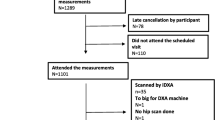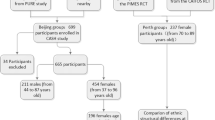Abstract
Dual-energy X-ray absorptiometry hip scans of 1,760 population-based Caucasians, 599 girls and 642 boys aged 6–19 years and 270 women and 249 men aged 20–90 years, were analyzed with the hip structural analysis (HSA) software to present age- and sex-specific normative HSA data of the femoral neck (FN). Measured traits included bone mineral density (BMD), cross-sectional area (CSA), section modulus (Z), periosteal diameter (PD), endosteal diameter (ED), cortical thickness (CT), and cross-sectional moment of inertia (CSMI). When plotting the measured traits versus age, the curves increased with higher ages until statistically significant break points were reached, for all traits at age 17 in girls and age 19 in boys. After the break points, PD and ED increased with higher ages but, as ED increased more than PD, BMD and CT decreased significantly with higher ages. The decline in BMD was counteracted by the increase in bone size so that there was only a nonstatistically significant decrease in bone strength, estimated as Z and CSMI, from break point to age 90. The partial preservation of bone strength was more obvious in men than in women as the decline in BMD was higher in women than in men, while the expansion in PD was larger in men than in women. The sex difference in the normative FN bone strength data seems to be related to sex discrepancies in the development of both bone mass and geometrical parameters during both growth and adulthood.


Similar content being viewed by others
References
WHO (1994) Assessment of fracture risk and its application to screening for postmenopausal osteoporosis. Report of a WHO Study Group. World Health Organ Tech Rep Ser 843:1–129
Heaney RP, Abrams S, Dawson-Hughes B, Looker A, Marcus R, Matkovic V, Weaver C (2000) Peak bone mass. Osteoporos Int 11:985–1009
Ahlborg HG, Johnell O, Turner CH, Rannevik G, Karlsson MK (2003) Bone loss and bone size after menopause. N Engl J Med 349:327–334
Kaptoge S, Beck TJ, Reeve J, Stone KL, Hillier TA, Cauley JA, Cummings SR (2008) Prediction of incident hip fracture risk by femur geometry variables measured by hip structural analysis in the study of osteoporotic fractures. J Bone Miner Res 23:1892–1904
Duan Y, Beck TJ, Wang XF, Seeman E (2003) Structural and biomechanical basis of sexual dimorphism in femoral neck fragility has its origins in growth and aging. J Bone Miner Res 18:1766–1774
LaCroix AZ, Beck TJ, Cauley JA, Lewis CE, Bassford T, Jackson R, Wu G, Chen Z (2010) Hip structural geometry and incidence of hip fracture in postmenopausal women: what does it add to conventional bone mineral density? Osteoporos Int 21:919–929
Zhang H, Hu YQ, Zhang ZL (2011) Age trends for hip geometry in Chinese men and women and the association with femoral neck fracture. Osteoporos Int 22:2513–2522
Riggs BL, Melton LJ 3rd, Robb RA, Camp JJ, Atkinson EJ, Peterson JM, Rouleau PA, McCollough CH, Bouxsein ML, Khosla S (2004) Population-based study of age and sex differences in bone volumetric density, size, geometry, and structure at different skeletal sites. J Bone Miner Res 19:1945–1954
Jackowski SA, Kontulainen SA, Cooper DM, Lanovaz JL, Baxter-Jones AD (2011) The timing of BMD and geometric adaptation at the proximal femur from childhood to early adulthood in males and females: a longitudinal study. J Bone Miner Res 26:2753–2761
Bachrach L (2008) Skeletal development in childhood and adolescence. In: Rosen C (ed) Primer on the metabolic bone diseases and disorders of mineral metabolism. American Society for Bone and Mineral Research, Washington, DC, pp 74–79
Orwoll ES (2003) Toward an expanded understanding of the role of the periosteum in skeletal health. J Bone Miner Res 18:949–954
Beck TJ, Looker AC, Ruff CB, Sievanen H, Wahner HW (2000) Structural trends in the aging femoral neck and proximal shaft: analysis of the Third National Health and Nutrition Examination Survey dual-energy X-ray absorptiometry data. J Bone Miner Res 15:2297–2304
Beck TJ, Ruff CB, Warden KE, Scott WW Jr, Rao GU (1990) Predicting femoral neck strength from bone mineral data. A structural approach. Invest Radiol 25:6–18
Yoshikawa T, Turner CH, Peacock M, Slemenda CW, Weaver CM, Teegarden D, Markwardt P, Burr DB (1994) Geometric structure of the femoral neck measured using dual-energy X-ray absorptiometry. J Bone Miner Res 9:1053–1064
Beck TJ, Oreskovic TL, Stone KL, Ruff CB, Ensrud K, Nevitt MC, Genant HK, Cummings SR (2001) Structural adaptation to changing skeletal load in the progression toward hip fragility: the Study of Osteoporotic Fractures. J Bone Miner Res 16:1108–1119
Crabtree N, Lunt M, Holt G, Kroger H, Burger H, Grazio S, Khaw KT, Lorenc RS, Nijs J, Stepan J, Falch JA, Miazgowski T, Raptou P, Pols HA, Dequeker J, Havelka S, Hoszowski K, Jajic I, Czekalski S, Lyritis G, Silman AJ, Reeve J (2000) Hip geometry, bone mineral distribution, and bone strength in European men and women: the EPOS study. Bone 27:151–159
Iki M, Dongmei N, Tamaki J, Sato Y, Kagamimori S, Kagawa Y, Yoneshima H (2011) Age-specific reference values of hip geometric indices from a representative sample of the Japanese female population: Japanese Population-based Osteoporosis (JPOS) Study. Osteoporos Int 22:1987–1996
Janz KF, Gilmore JM, Levy SM, Letuchy EM, Burns TL, Beck TJ (2007) Physical activity and femoral neck bone strength during childhood: the Iowa Bone Development Study. Bone 41:216–222
Janz KF, Burns TL, Levy SM, Torner JC, Willing MC, Beck TJ, Gilmore JM, Marshall TA (2004) Everyday activity predicts bone geometry in children: the Iowa Bone Development Study. Med Sci Sports Exerc 36:1124–1131
Forwood MR, Baxter-Jones AD, Beck TJ, Mirwald RL, Howard A, Bailey DA (2006) Physical activity and strength of the femoral neck during the adolescent growth spurt: a longitudinal analysis. Bone 38:576–583
Alwis G, Linden C, Ahlborg HG, Dencker M, Gardsell P, Karlsson MK (2008) A 2-year school-based exercise programme in pre-pubertal boys induces skeletal benefits in lumbar spine. Acta Paediatr 97:1564–1571
Forwood MR, Bailey DA, Beck TJ, Mirwald RL, Baxter-Jones AD, Uusi-Rasi K (2004) Sexual dimorphism of the femoral neck during the adolescent growth spurt: a structural analysis. Bone 35:973–981
Karlsson MK, Gardsell P, Johnell O, Nilsson BE, Akesson K, Obrant KJ (1993) Bone mineral normative data in Malmo, Sweden: comparison with reference data and hip fracture incidence in other ethnic groups. Acta Orthop Scand 64:168–172
Duppe H, Gardsell P, Johnell O, Nilsson BE, Ringsberg K (1997) Bone mineral density, muscle strength and physical activity: a population-based study of 332 subjects aged 15–42 years. Acta Orthop Scand 68:97–103
Sundberg M, Gardsell P, Johnell O, Ornstein E, Sernbo I (1998) Comparison of quantitative ultrasound measurements in calcaneus with DXA and SXA at other skeletal sites: a population-based study on 280 children aged 11–16 years. Osteoporos Int 8:410–417
Duke PM, Litt IF, Gross RT (1980) Adolescents’ self-assessment of sexual maturation. Pediatrics 66:918–920
Hind K, Burrows M (2007) Weight-bearing exercise and bone mineral accrual in children and adolescents: a review of controlled trials. Bone 40:14–27
MacKelvie KJ, Khan KM, McKay HA (2002) Is there a critical period for bone response to weight-bearing exercise in children and adolescents? A systematic review. Br J Sports Med 36:250–257
Kim HJ, Fay MP, Feuer EJ, Midthune DN (2000) Permutation tests for join point regression with applications to cancer rates. Stat Med 19:335–351
Bailey DA, McKay HA, Mirwald RL, Crocker PR, Faulkner RA (1999) A six-year longitudinal study of the relationship of physical activity to bone mineral accrual in growing children: the University of Saskatchewan Bone Mineral Accrual Study. J Bone Miner Res 14:1672–1679
Faulkner RA, Bailey DA, Drinkwater DT, McKay HA, Arnold C, Wilkinson AA (1996) Bone densitometry in Canadian children 8–17 years of age. Calcif Tissue Int 59:344–351
Lee SH, Desai SS, Shetty G, Song HR, Lee SH, Hur CY, Lee JC (2007) Bone mineral density of proximal femur and spine in Korean children between 2 and 18 years of age. J Bone Miner Metab 25:423–430
Augat P, Reeb H, Claes LE (1996) Prediction of fracture load at different skeletal sites by geometric properties of the cortical shell. J Bone Miner Res 11:1356–1363
Smith RW Jr, Walker RR (1964) Femoral expansion in aging women: implications for osteoporosis and fractures. Science 145:156–157
Ruff CB, Hayes WC (1988) Sex differences in age-related remodeling of the femur and tibia. J Orthop Res 6:886–896
Rivadeneira F, Zillikens MC, De Laet CE, Hofman A, Uitterlinden AG, Beck TJ, Pols HA (2007) Femoral neck BMD is a strong predictor of hip fracture susceptibility in elderly men and women because it detects cortical bone instability: the Rotterdam Study. J Bone Miner Res 22:1781–1790
Seeman E, Duan Y, Fong C, Edmonds J (2001) Fracture site-specific deficits in bone size and volumetric density in men with spine or hip fractures. J Bone Miner Res 16:120–127
Duan Y, Parfitt A, Seeman E (1999) Vertebral bone mass, size, and volumetric density in women with spinal fractures. J Bone Miner Res 14:1796–1802
Nordstrom P, Neovius M, Nordstrom A (2007) Early and rapid bone mineral density loss of the proximal femur in men. J Clin Endocrinol Metab 92:1902–1908
Travison TG, Beck TJ, Esche GR, Araujo AB, McKinlay JB (2008) Age trends in proximal femur geometry in men: variation by race and ethnicity. Osteoporos Int 19:277–287
Bacon WE, Maggi S, Looker A, Harris T, Nair CR, Giaconi J, Honkanen R, Ho SC, Peffers KA, Torring O, Gass R, Gonzalez N (1996) International comparison of hip fracture rates in 1988–89. Osteoporos Int 6:69–75
Kanis JA, Johnell O, De Laet C, Jonsson B, Oden A, Ogelsby AK (2002) International variations in hip fracture probabilities: implications for risk assessment. J Bone Miner Res 17:1237–1244
Beck T (2003) Measuring the structural strength of bones with dual-energy X-ray absorptiometry: principles, technical limitations, and future possibilities. Osteoporos Int 14(suppl 5):S81–S88
Heinonen A, McKay HA, Whittall KP, Forster BB, Khan KM (2001) Muscle cross-sectional area is associated with specific site of bone in prepubertal girls: a quantitative magnetic resonance imaging study. Bone 29:388–392
Acknowledgments
Financial support for this study was received from the ALF and FoUU Foundations, the Kock Foundation, and the Skane University Hospital Foundations.
Author information
Authors and Affiliations
Corresponding author
Additional information
The authors have stated that they have no conflict of interest.
Rights and permissions
About this article
Cite this article
Alwis, G., Karlsson, C., Stenevi-Lundgren, S. et al. Femoral Neck Bone Strength Estimated by Hip Structural Analysis (HSA) in Swedish Caucasians Aged 6–90 Years. Calcif Tissue Int 90, 174–185 (2012). https://doi.org/10.1007/s00223-011-9566-1
Received:
Accepted:
Published:
Issue Date:
DOI: https://doi.org/10.1007/s00223-011-9566-1




